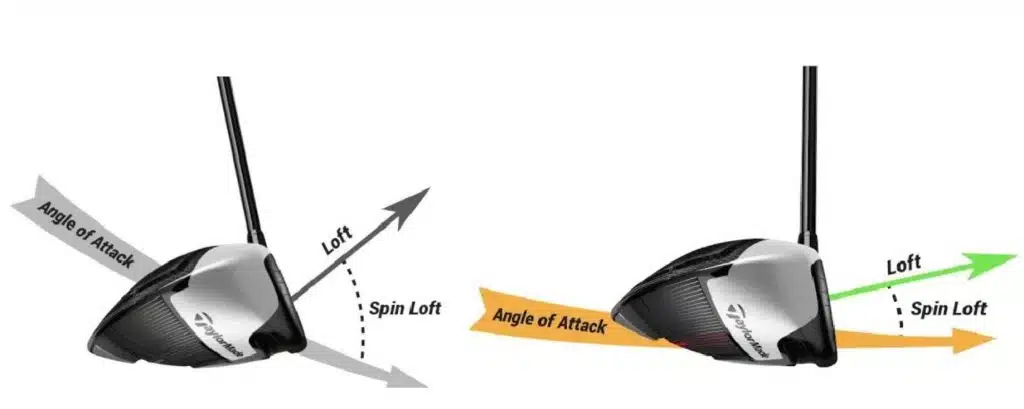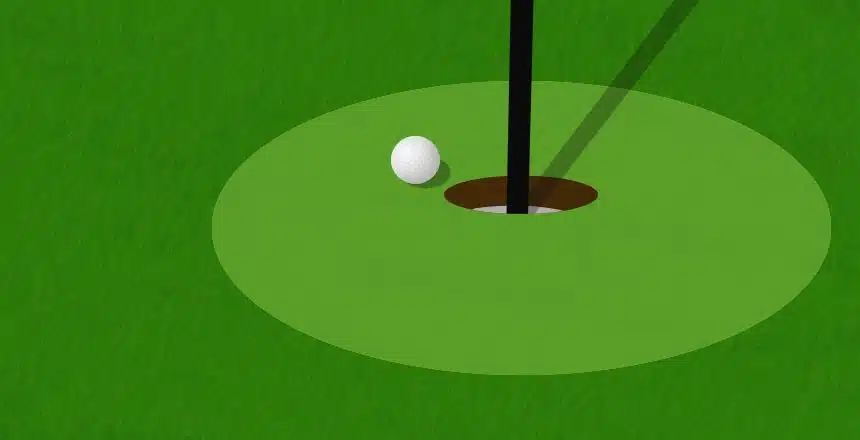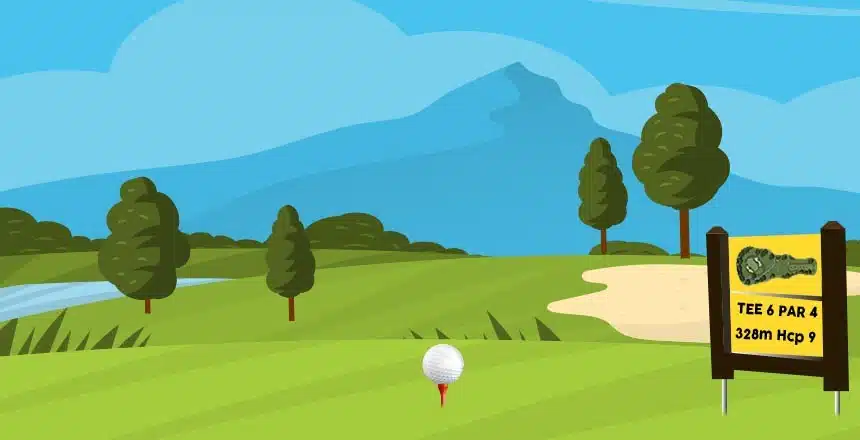Only a few understand the brute force in play at the time of contact between golf club and golf ball. This moment of impact plays a major role when it comes to determining distance, spin, trajectory, and more crucial factors like these.
Golfers with a faster swing speed (over 100 mph) automatically achieve a greater clubhead speed (over 150 mph), thus the ball just rockets far off. And it’s all because of an all-out angle of attack during the swing that simply tears through that golf ball.
So the attack angle or angle of attack (one and the same thing) is something that cannot be overlooked. In that case, let’s find out what it really means and what it’s capable of doing.
In This Post
What Is Angle of Attack In Golf?

The angle of attack in golf is a measurement of the direction at which your club is moving when you make contact with the ball. It is measured in degrees and signifies one of the major driving forces behind spin rate, launch angle, and carry. In simple terms, the angle refers to the club’s direction, while attack refers to the moment of contact.
A sliding scale is used to judge the angle of attack. The more you hit down on the ball, the steeper your angle. Conversely, the more your club glides across the top of the turf, the shallower your angle.
How Club Selection Affects Attack Angle
Club selection plays a significant role in determining your angle of attack. Wedges tend to produce the steepest angles, while drivers yield the shallowest angles. As you move from your most to least lofted clubs, your angle of attack will gradually decrease. However, the variance in attack angle throughout your entire bag is only about 10 degrees.
When the blow is ascending, the attack angle is positive while it’s negative when you have a descending blow.
To be honest, recreational golfers don’t even have to think about this particular factor in golf. But, on the other hand, competitive play requires you to improve your game in every which way in order to score better. And that could also mean fixing potential angle of attack problems.
ANGLE OF ATTACK – TOUR AVERAGES
- Men: -1.0 degrees (driver), -4.1 degrees (6-iron)
- Women: +2.0 degrees (driver), -2.3 degrees (6-iron)
ATTACK ANGLE DRIVER – MALE & FEMALE AMATEURS
- Men: -2.1 degrees (bogey golfer), -1.8 degrees (average golfer), -1.2 degrees (10-handicap golfer), -1.1 degrees (5-handicap golfer), -0.9 degrees (scratch golfer)
- Women: -2.3 degrees (15-handicap golfer), -1.7 degrees (10-handicap golfer), -1.8 degrees (5-handicap golfer), -0.9 degrees (scratch golfer)
Steep Angle of Attack
A steep angle of attack occurs when you hit down on the ball. With an excessively steep angle, you sacrifice distance because your launch angle will also be low, limiting carry distance. It’s understandable to hit the ball at -10 degrees with your wedges, but ideally, your angle of attack should be about half of that, or closer to -5 degrees for all wedges.
If you’re hitting your driver at a -10 degrees angle of attack, there’s room for improvement. Reducing this number will result in better golf shots overall, as your ball speed will increase without changing your swing speed, and your shot dispersion will tighten. With less turf/club interaction, you’ll also see a more consistent distance window with each club.
Shallow Angle of Attack
In most cases, a shallow angle of attack is ideal. Your divots are small, your shots are high, and the angle of descent on your golf ball is predictable. A shallow angle of attack means coming through the ball at just a few degrees negative. With the driver, it can even be better to connect at a degree or two positive.
Hitting up on the ball is a technique that every pro will emphasize during a driver lesson to increase carry distances and reduce spin, resulting in more piercing strikes.
Attack Angle Ideals Throughout the Bag
Here’s a breakdown of ideal attack angles for various clubs:
| Club | Attack Angle |
|---|---|
| Driver | -1.3 degrees |
| 3-Wood | -2.9 degrees |
| 5-Wood | -3.3 degrees |
| Hybrid 16-degree | -3.5 degrees |
| 3-Iron | -3.1 degrees |
| 4-Iron | -3.4 degrees |
| 5-Iron | -3.7 degrees |
| 6-Iron | -4.1 degrees |
| 7-Iron | -4.3 degrees |
| 8-Iron | -4.5 degrees |
| 9-Iron | -4.7 degrees |
| 48-degree Wedge | -5.0 degrees |
| 52-degree Wedge | -5.2 degrees |
| 56-degree Wedge | -5.5 degrees |
| 60-degree Wedge | -5.8 degrees |
What the Pros Do
Professional golfers maintain a compact angle of attack range. While amateurs might have a variance of 10-15 degrees, PGA golfers can have a variance as little as 5 degrees. Their swings are consistent regardless of the club in their hands, and their results show.
Observe the divots that pros take with woods and long irons. Their clubs glide across the top of the turf at very shallow angles, producing minimal divots, high launch angles, and impressive carry distances.
As they progress through their bag, the launch angle may drop up to around 6 degrees, but hardly ever lower. When the angle of attack goes lower, that’s when you start to see inconsistent ball flights that can disrupt your game.
LPGA golfers hit the ball further than amateur golfers, even with lower swing speeds. These players utilize higher angles of attack to increase carry and total distance. PGA golfers average around 0 degrees of attack angle with their driver, while LPGA players range between 2 to 3 degrees.
Distance results are a product of increased launch angles and consistent swing paths. While there is hardly a substitute for swinging harder, optimizing launch angle for carry can help compensate for deficiencies in swing speed.
What Amateurs Do
Amateur golfers tend to have steeper angles of attack than professional golfers. Lower swing speeds and steeper angles of attack are two major reasons why less-skilled players are out-distanced by highly-skilled players. There is often a strong correlation between the ability to shallow the club and a golfer’s skill level.
When it comes to angle of attack, consistency is key. Even if you err on the side of being too steep or too shallow, consistency breeds predictability.
Amateur golfers are often unpredictable. As you move up the handicap scale, golfers become less consistent in various shot metrics, including angle of attack.
This inconsistency leads to situations where a player who averages 130 yards with their 9-iron might hit shots at 120 yards and 145 yards in the same round. Swing speed may be consistent, but other factors change when the angle of attack wavers. When the attack angle becomes more consistent, distance variation shrinks, and fewer greens are missed long or short.
Angle of Attack – Understanding Spin
The best shots in golf are actually a result of an attack angle that’s shallow combined with a higher golf club loft. That’s how you’re able to generate greater backspin – when you hit down on that ball.
But then hitting down doesn’t necessarily always produce more spin. The spin rate of the golf ball is majorly generated by a combination of several factors. These include clubhead speed and spin loft, along with friction between ball and club and also the impact position.
A higher-lofted golf club, generally, increases spin. As for spin loft, this is the difference (measured in degrees) between the attack angle and loft angle of the club. When this numerical angle difference is greater, then spin also increases. And vice versa.
Hitting down on the golf ball gives you a lower launch but then it ensures the same spin rate. The angle of attack must be shallow while also preserving the loft of the golf club for producing spin on the ball and making it stop once it touches the green.
Angle of Attack – How It Affects Golf Swing and Ball Flight
A badly hit golf shot is an inevitable outcome of a too shallow or too steep angle of attack.
The attack angle with irons, since hitting down with the iron on the golf ball is how it’s supposed to be, is descending. And that with drivers is ascending because the contact between driver and ball is made on the upswing movement of the driver in order to maximize distance.
Ask just about any Tour player and he/she will tell you how much (and how dedicatedly) they focus and rely on the attack angle golf parameter for hitting Tour-grade shots.
So here are all the important factors of ball flight and golf swing that are determined by the angle of attack…
Smash Factor
When your attack angle with a golf iron is too steep, all of that much-needed, extra energy at impact is not transferred to the ball. Rather it’s wasted into the ground. That’s how you end up with fat shots and deep, sometimes chunky divots.
Spin
Once again, an angle of attack too steep produces excessive spin, which is not what you need when it’s too windy or even in the case of crosswinds.
But, on the other hand, if you take a shallow approach to the attack angle, you eliminate the possibility of too much spin. Thus, creating that perfectly stable and penetrating trajectory, no matter the wind or weather conditions.
Launch Angle
For an optimal launch angle with your driver, hitting up on the golf ball is the most effective strategy. This has proven to increase distance potential. So make sure that your angle of attack is positive.
Distance
You’re bound to lose distance in the case of an off attack angle. To avoid that, try changing from a negative angle of attack to a positive angle of attack (even by a few degrees). This, in turn, adds 20-30 extra yards just like that without having to increase the clubhead speed.
In the end, it’s as simple as maximizing force transferred to the golf ball through a correct attack angle. Hence, greater smash factor, greater distance, and more stable and piercing ball flight even when windy.
Do I Need to Swing Faster to Improve Distance?
You do not need to increase swing speed to improve your attack angle or distance. If you want to see added distance, a great place to start is by optimizing your launch angle.
Shallowing your angle of attack can help you achieve this. By hitting more up on the ball or less down, depending on your perspective, you can make it easier to launch the ball and even raise ball speed.
Instead of focusing on generating swing speed, which can often exacerbate flaws in your swing, adjusting your angle of attack is a minor change that can lead to added distance without sacrificing accuracy.
A Quick Fix to Increase Launch Angle
An easy way to make your angle of attack less steep is to move the ball forward in your stance. Consider this on a smaller scale with chipping. If you want to hit a higher pitch, move the ball forward in your swing. If you want to hit a punch or low runner, move the ball back in your stance. You can create shots of varying heights with the same club by adjusting your angle of attack and club loft.
Scaling this up, when using a mid-iron, moving the ball up in your stance allows you to shallow your launch angle and hit the ball higher. You’re making contact later in the swing, on the way up, which can add distance in most cases.
The Case for a Real Analysis
A thorough analysis of your angle of attack cannot be accomplished through casual observations made while playing. It requires precise measurements and large sample sizes.
Judging yourself from a few swings at a driving range doesn’t provide a complete picture, and given the inconsistencies of amateur golfers, it may do more harm than good.
To fully understand your angle of attack and how to improve it, you need a comprehensive analysis with computer-generated statistics.
Knowing your numbers and understanding what needs improvement is the only way to guarantee results when stepping back onto the course.
Does Angle of Attack Really Matter Then?
If you want to become a better golfer, then producing the right attack angle can make a whole lot of difference in your level of play. When miles out of line, the angle of attack totally messes up your golf swing, thus leading to poorly hit shots.
A good example would be hitting your wedges with a too shallow angle of attack. You’ll see how this approach, and maybe even when you hit up a little bit, doesn’t generate enough spin for stopping the shot quickly on those firm greens.
So to avoid these kinds of mishaps, you have to understand how the angle of attack works. And how a steeper attack angle or swing can turn out to be a HUGE success!





I’m not sure what angle of attack you are referring to in golf, but it sounds like you are talking about a different game. In golf, the angle of attack is the angle at which the clubface is directed at the ball.